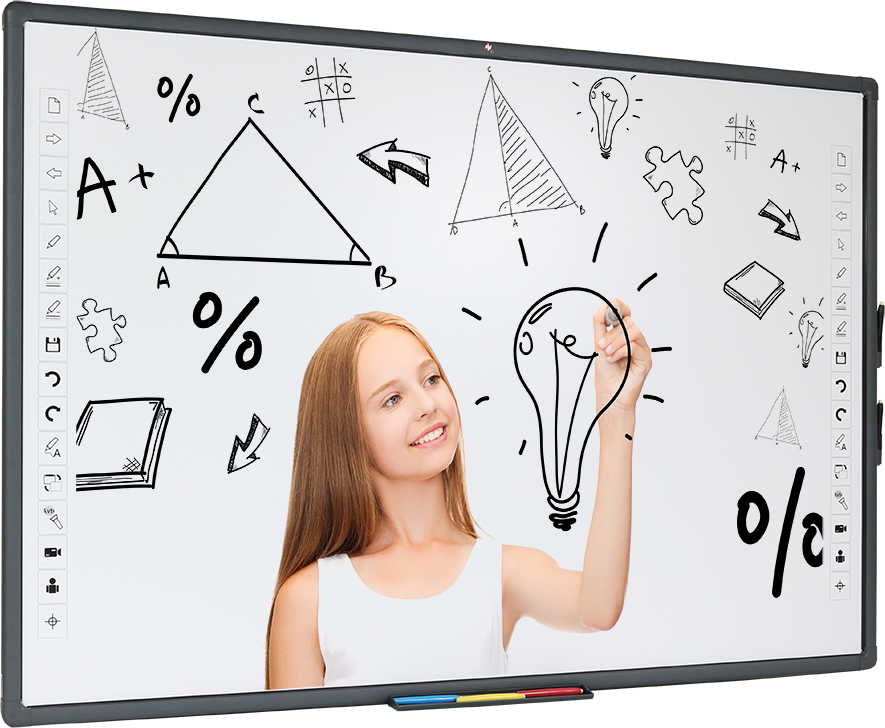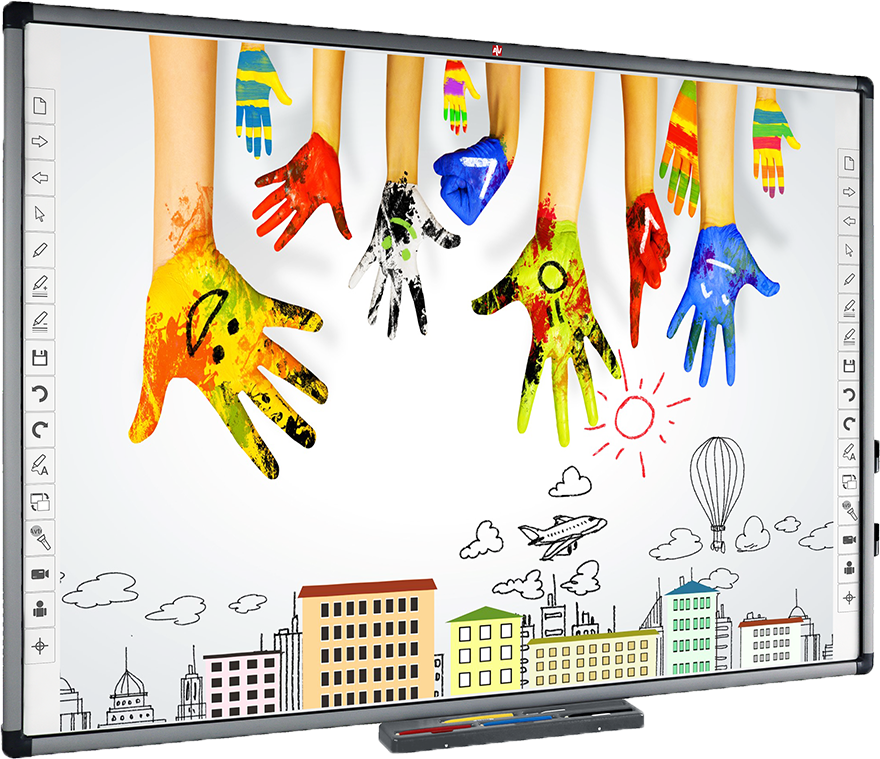
The interactive whiteboard is one of the most popular modern aids in schools, where it is gradually replacing the traditional whiteboards and old-fashioned chalk blackboards. Taking advantage of its rich functionality and practical applications, with the aid of dedicated software, a creative teacher can use an interactive whiteboard to take their teaching methodology to a whole new level. However, as opposed to interactive displays, interactive whiteboards are not standalone, self-contained devices. In order to give the user the full range of their capabilities, they need to be used as part of a set, whose other essential components include:
In this scenario, the whiteboard will be the device that provides the touch detection feature that enables the users to interact with the content displayed. The interactive whiteboard, which – depending on the technology – can be operated with a finger (optical, infra-red positioning or capacitive technology whiteboards) or with a dedicated pen (electromagnetic ones).
The full set naturally needs to include a few more components, such as a whiteboard mounting solution and a projector mount, the cabling and possibly an additional pair of speakers, where those built in the PC or the whiteboard are not sufficient. Interactive whiteboards can be used to display just about anything a PC can show on its screen: Microsoft Office programs, websites, photos and videos in every format. Their key strength however lies in enabling the user to fully interact with all those types of content. While standing at the whiteboard, the user can operate any software application that runs on the connected PC, being able to write, mark, highlight, annotate and doodle on any image, chart, diagram or text that is being displayed. All the notes made using the whiteboard can be saved, distributed by e-mail, uploaded to the school server or printed out. An interactive whiteboard also includes the bundled software that extends its capabilities and can additionally provide some utilities and aids dedicated to specific school subjects.

The surface is the most visible and the most important component of the interactive whiteboard, so it is essential that it meets certain basic requirements regarding its physical properties and quality.
It is indeed very practical that an interactive whiteboard is also a conventional whiteboard that can be drawn on with dry erase pens, for example when the projector fails or during a power outage.
A good interactive whiteboard has a magnetic surface, which reliably holds magnets or magnet-based office or school accessories placed on it. In other words, an interactive whiteboard should also be able to serve as a conventional magnetic whiteboard. That said, one should remember that if an interactive whiteboard is operated by touch, using its magnetic properties may in some cases be impractical, as placing an object on its surface can be identified by the system as user interaction, making it more difficult to control the pointer.
Durability is an essential aspect of every piece of school equipment. Interactive whiteboards that use optical or infra-red technology are almost completely resistant to damage. In that type of devices touch is detected by cameras or sensors installed in the whiteboard bezel, so even a heavy damage of their drawing surface will not affect their touch-dependent interactive functions in any way.
At present, the most popular models are those similar by size to typical school whiteboards, whose workspaces have a diagonal of approx. 80”, which means a projection and touch area size of approx. 164 by 114 centimetres (65 by 45 inches). Practice has proven that size to be optimal both for the creative use of the touch features, as well as for the use of the whiteboard as a projection screen – or as a conventional dry-erase whiteboard if needed. An approximately 80-inch whiteboard will be an optimal solution even for a larger classroom, ensuring satisfactory visibility even to the students sitting at the very back. Still, it should be pointed out that whiteboards of that size typically have the 4:3 ratio, which is quickly becoming an obsolete format, incompatible with state-of-the-art multimedia technology. This is even more true if one remembers that in a vast percentage of cases the interactive whiteboard is bundled with a laptop PC equipped with a panoramic 16:9 display, the screen aspect ratio which a majority of recent educational content – such as videos or websites – is designed for. When displayed on a 4:3 whiteboard, such content leaves a large part of its surface unused and can pose issues when the user tries to rescale it to fill the projection surface more efficiently.
For those reasons, if the interactive whiteboard is to be used with modern educational multimedia and fit future content, a purchase of a panoramic model instead is definitely worth considering. The most popular whiteboards with a ratio of 16:10 or 16:9 have a diagonal of approx. 100 inches and offer an even larger image, thanks to which they do their job much better in larger conference rooms and classrooms.
Shortcut toolbars
Toolbars are usually available along the edges of interactive whiteboards to provide easy access to selected functions. Interoperating with the software app bundled with the whiteboard, they enable the user to switch easily between the pen modes and the eraser mode, or to easily save everything that has been scribbled on the screen so far with a single touch of a shortcut button, eliminating the need to go through the entire on-screen menu each time.
Interactive Shelf
A simple tool that lets the user change the colour of the pen or select the eraser simply by lifting an item from an appropriate slot of a shelf located at the bottom edge of the whiteboard. Simple, reliable and practical.